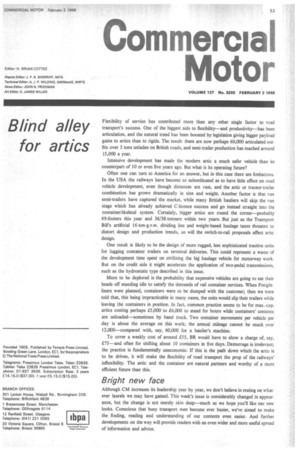Blind alley for artics
Page 55

If you've noticed an error in this article please click here to report it so we can fix it.
Flexibility of service has contributed more than any other single factor to road transport's success. One of the biggest aids to flexibility—and productivity—has been articulation, and the natural trend has been boosted by legislation giving bigger payload gains to artics than to rigids. The result: there are now perhaps 60,000 articulated outfits over 3 tons unladen on British roads, and semi-trailer production has reached around 15,000 a year.
Intensive development has made the modern attic a much safer vehicle than its counterpart of 10 or even five years ago. But what is its operating future?
Often one can turn to America for an answer, but in this case there are limitations. In the USA the railways have become so subordinated as to have little effect on road vehicle development, even though distances are vast, and the artic or tractor-trailer combination has grown dramatically in size and weight. Another factor is that van semi-trailers have captured the market, while many British hauliers will skip the van stage which has already achieved C-licence success and go instead straight into the container/skeletal system. Certainly, bigger artics are round the corner—probably 49-footers this year and 36/38-tonners within two years. But just as the Transport Bill's artificial 16-ton-g.v.w. dividing line and weight-based haulage taxes threaten to distort design and production trends, so will the switch-to-rail proposals affect artic design.
One result is likely to be the design of more rugged, less sophisticated tractive units for lugging container trailers on terminal deliveries. This could represent a waste of the development time spent on civilizing the big haulage vehicle for motorway work. But on the credit side it might accelerate the application of two-pedal transmissions, such as the hydrostatic type described in this issue.
More to be deplored is the probability that expensive vehicles are going to eat their heads off standing idle to satisfy the demands of rail container services. When Freight liners were planned, containers were to be dumped with the customer; then we were told that, this being impracticable in many cases, the units would slip their trailers while leaving the containers in position. In fact, common practice seems to be for max.-cap.
artics costing perhaps £5,000 to £6,000 to stand for hours while containers' contents are unloaded—sometimes by hand truck. Two container movements per vehicle per day is about the average on this work; the annual mileage cannot be much over 12,000—compared with, say, 60,000 for a haulier's machine.
To cover a weekly cost of around £55, BR would have to show a charge of, say, £15—and often for shifting about 10 containers in five days. Demurrage is irrelevant; the practice is fundamentally uneconomic. If this is the path down which the artic is to be driven, it will make the flexibility of road transport the prop of the railways' inflexibility. The artic and the container are natural partners and worthy of a more efficient future than this.




































































































































































































